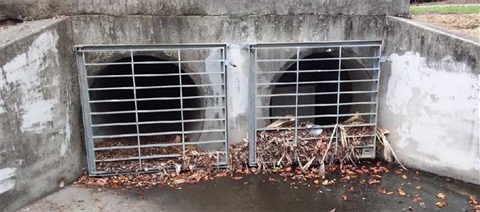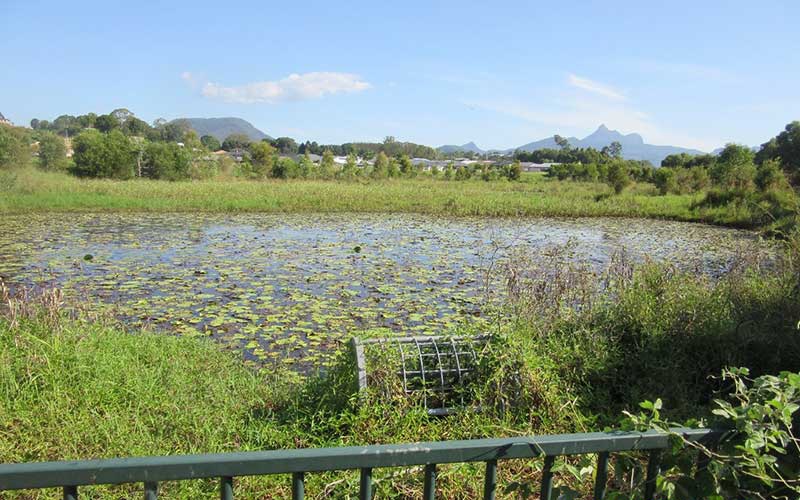Stormwater

Stormwater is rainwater that flows across land surfaces.
Our stormwater system includes street gutters, drains, underground pipes, and channels that transport rainwater to waterways.
Council's public stormwater infrastructure includes:
- 350 km of circular pipes
- 33 km of open channels
- 6 km of box culverts
- 182 gross pollutant traps
- 17,394 pits, manholes and headwalls.
Wastewater is water that goes down our sinks, showers, toilets and floor drains.
Report a problem
If you see something that needs attention, complete the online form.
Preventing water pollution
The best way to reduce stormwater pollution is to stop it entering our waterways.
As water flows over land, it picks up pollutants and washes them into our rivers, lakes, estuaries, beaches and groundwater:
- litter: cigarette butts, straws, plastic bags
- chemicals: fertilisers and pesticides from agriculture and gardens, heavy metals, oils from road surfaces, detergents
- natural pollution: leaves, garden clippings, animal droppings
- pathogens: viruses and bacteria from leaking septic tanks
- sediments: soil erosion from construction sites, unsealed roads, riverbanks that lack vegetation.
What can you do?
- Sweep up leaves and garden clippings.
- Put cigarette butts in the bin.
- Clean up paint brushes the right way.
- Use a car wash that recycles water.
Stormwater pollution tips(PDF, 3MB)
Section 68 approvals (stormwater drainage works)
Section 68 approvals are often additional to standard development application (DA) requirements.
Council is the only authority that can issue section 68 approvals. Approvals are required for community health and safety.
Council approval is needed for the following 3 works.
Connecting a private stormwater drain to a public drain
For example, installing a pipe to carry roof water or hardstand drainage from a private property, across a public road, road reserve, footpath or nature strip to connect to a Council kerb or stormwater drainage system.
Installing a permanent stormwater quality control device
For example, installing gross pollutant traps and oil and sediment arrestors in a private drainage system that ultimately discharges to a public stormwater drainage system. (Excludes single dwellings or dual occupancies.)
Carrying out mandatory erosion and sediment control works
- For development that involves ground surface disturbance of more than 35m2.
- For excavation or earthworks involving removal or placement of more than 5m3 of soil, such as swimming pools or in ground water tanks. (Excludes house and ancillary construction on rural properties where the construction zone is separated by more than 50m to a water course by a natural sediment barrier such as grass.)
Section 68 approvals are required under the Local Government Act 1993.
To find out how to apply for a Section 68 approval, including required attachments and fees, head to Associated Applications for Development.
Specifications and standard drawings
Refer to Council's engineering standard drawings when designing and constructing stormwater assets in the Tweed.
See engineering specifications.
Stormwater easements
Easements are sections of land set aside for public infrastructure and utility services.
Council and upstream property owners may have the right to direct stormwater through (or discharge onto) an easement.
No structures, building or landscaping are allowed in or near easement boundaries.
Interallotment drainage systems move private property stormwater across other properties to a Council drainage system. They're usually located along the rear boundary with a single grated inlet for each property.
Property owners are responsible for the maintenance and service of interallotment drainage systems (details are usually included in property legal documents).
Stormwater disputes
If stormwater is running onto your property from a neighbour's property, you need to talk to your neighbour. This is a private matter, not a matter for Council.
Seek advice from a licensed plumber and drain layer about the water source and the best way to fix the problem.
Always maintain your stormwater drains to prevent pollution, property damage and flooding.
Tweed Urban Stormwater Quality Management Plan
Stormwater runoff from existing and proposed development has a significant impact on the environmental and recreational value of Tweed Waterways. The Tweed Urban Stormwater Quality Management Plan(PDF, 4MB) sets out Council’s rationale and policy objectives for stormwater management, and supports the Development Design Specification D7 – Stormwater(PDF, 552KB) which is currently used to guide the design and construction of water quality protection devices associated with development.
Water sensitive urban design

Water sensitive urban design slows stormwater runoff by imitating the natural water balance on site before land is built on.
Water is naturally cleaned and filtered by soil and plants before it gets to waterways.
Council policies ensure large new developments include water sensitive urban design principles. Council includes these design principles in park and street upgrades where possible.
Banora Point drainage scheme
This open channel stormwater drainage system extends from Lochlomond Drive and discharges into Trutes Bay and Shallow Bay. It was built to enable development of Banora Point.
Banora Point drainage scheme
This scheme supports water habitat for animals, particularly the Comb-crested Jacana bird (listed as vulnerable under the NSW Threatened Species Conservation Act).
The open channels and lakes within the scheme are fresh water (apart from Lake Kimberley which has some tidal flushing).
Fresh water systems present challenges for aquatic weed control. In recent times the area has been increasingly infested by noxious weeds such as 'salvinia molesta' and 'cabomba caroliniana'.
Other aquatic plants present in large quantities include:
- Parrot’s Feather
- Wandering Jew
- Waterlilies
- Red Azolla (or Water Fern)
Water lillies provide nesting and foraging areas for Comb-crested Jacana birds, and must not be disturbed during nesting season (November to August).
Council’s main focus is controlling the growth of salvinia. This plant floats on the surface and in warmer months can double in size in 2 to 3 days. Methods used to control this weed include:
- Removal by mechanical harvester. This method is used in the larger ponds of Vintage Lakes and channels in the Banora Waters areas. The weed is removed from site and can be used as a fertiliser. Care must be taken when harvesting that waterlilies are not damaged and that the underwater cabomba weed is not accidently propagated by disturbance.
- Biological control using the ant-sized non-native weevil Cyrtobagous salviniae. This method is used in the Club Banora Golf Course moat where the weevil effectively kills the weed by feeding on the tips of the leaf and tunnelling through the plant stems. The plant noticeably changes colour from a bright green to a dark brown when the weevil activity is strong. The main constraint to this method is that shaded and cooler areas limit the weevil population and activity.
- elective herbicide spraying (carried out by Far North Coast Weeds on behalf of Council)
See water pollution
At the moment there's no effective method of controlling the underwater cabomba weed. Trials are being carried out by research organisations such as CSIRO and Department of Primary Industries, and Council will be guided by their recommendations.
The Vintage Lakes ponds often have growth periods of the Red Azolla plant. This plant is a native aquatic fern and is not targeted for removal from the waterways (unless salvinia is also present and requires removal). Red Azolla can help to prevent algae blooms by competing with algae for nutrients.
